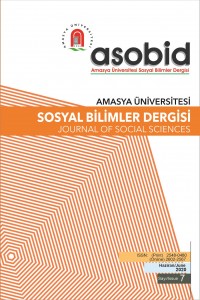1960’LI YILLARDAN SONRA AZERBAYCAN NESRİNDE KONU VE TEMA YÖNÜNDEN DEĞİŞİMLER, İSİ MELİKZADENİN “AĞRI” HİKÂYESİNİN TÜRKÇEYE AKTARIMI
Abstract
Zengin ve köklü bir mirasa sahip olan Azerbaycan Edebiyatı, Stalin’in yönetime gelmesi ve 1937-1939’lu yıllarda uyguladığı etnik, ideolojik temizleme, baskı ve tehditle özgünlükten yoksun bir edebiyat haline gelmiştir. Bu dönemde edebiyatın şekillenmesi de partinin, yönetimin istekleri doğrultusunda gelişmiştir. Nitekim, Sovyet Azerbaycan Edebiyatı’nın sanat değeri taşıyan eserlere kavuşması, belirtilen tarihten yaklaşık 25-30 yıl sonra, yani Stalin’in ölümünden sonraki 1960’lı yıllara denk gelmektedir. Aslında Stalin zamanında direkt olmasa da yönetime, halkın yozlaştırılmasına karşı gelen muhalif yazarlar eserlerinde millî görüşlerini, mefkûrelerini imge ve sembollerle, satır aralarında veriyorlardı. 1960’lı yıllardan sonra yetişen genç yazarların eserlerinde Rus yönetimine, Ruslaşmış idari kadrolara, oturmuş idari düzene velhasıl yönetime itirazlarının başladığını görmekteyiz. Bu döneme kadar yazılan eserler, “Sovyet insanını”, “Sovyet düzenini” öven, güdümlü eserlerdi. Stalin’in ölümünden sonra sosyal ve siyasi ortamda oluşan yumuşama ve kısmi özgürlükler genç yazarlara toplumun yıllardır kanayan yaralarını direk olmasa da imge ve sembollerle dile getirme, ışık tutma olanağı sağlamıştır. 1960’lı yıllar edebî nesli başlı başına bir ekol olan yeni bir edebî anlayış başlatmıştır. Bu anlayışa bağlı olan yazarlar, toplumcu gerçekçiliğin kalıplarını yıkarak, yeni bir nesir anlayışıyla özgün eserler vererek, Azerbaycan Edebiyatı’nda büyük iz ve zengin miras bıraktılar. Çalışmamızda hikâyesini Türkiye Türkçesine aktardığımız Azerbaycan edebiyatının güçlü kalemlerinden biri olan İsi Melikzade, Sovyet dönemi Azerbaycan edebiyatındaki 1960’lı yıllar nesri edebî ekolü yazarları arasında yerini alır. İsi Melikzade, yeni bir nesir anlayışının temellerini atan ve kendinden sonraki birçok yazar üzerinde etkisi görülen önemli yazarlardan biri olarak Azerbaycan Edebiyatında önemli bir yere sahiptir. İsi Melikzade’nin eserlerinde unutulmuş, arka plana itilmiş sade insanların köy hayatını, bu hayatın zorluklarını, kırsalın bilinen ve bilinmeyen zorluklarını daha önce hiç işlenmemiş şekilde en çarpıcı ifadelerle işlendiğini görmekteyiz. İsi Melikzade’nin “Ağrı” hikâyesi de otobiyografik özellik taşımasının yanı sıra aynı zamanda 1960 sonrası köy hayatını ve sorunlarını en güzel anlatan hikâyelerden biri olma özelliğine sahiptir.
References
- Abbasova, Sevinc (2007). “İsi Melikzade”. Müasir Azerbaycan Edebiyyatı. (Ed. C. M. Abdullayev vd.). Bakı: Bakı Universiteti Neşriyyatı, II. Cilt, s.95-107.
- Durmuş, Mitat (2002). “Bolşevik İhtilâlinden Sonraki Azerbaycan Sahası Türk Edebiyatında Şiir ve Poema Türü”. Türkoloji. C. 15, S. 1, s. 261-267.
- Melikzade, İsi (1987). Gümüşgöl Efsanesi; Roman, Povest ve Hekayeler. Bakı: Yazıçı.
- Moran, Berna (2014). Edebiyat Kuramları ve Eleştiri. 25. Baskı, İstanbul: İletişim Yayınları.
- Yusifli, Vagif (2005). İsi Melikzade Seçilmiş Eserleri. Bakı: Şerq-Qerb.
THEME AND SUBJECT CHANGES IN AZERBAIJAN PROSE AFTER THE 1960'S, THE TRANSLATION OF ISI MELIKZADE'S "AĞRI" STORY INTO TURKISH LANGUAGE
Abstract
With the coming of Stalin into the governance, the Azerbaijan literature, with the deep and rich heritage has become a literature devoid of originality between the 1937-1939's with etnic and ideological cleansing policy. The shaping of literature in this period also developed in line with the demands of the party and the administration. As a matter of fact, the achievement of Soviet Azerbaijani Literature with works of art value coincides approximately 25-30 years after the specified date, that is, the 1960s after Stalin's death. In fact, in Stalin's time, there were also writers with national view who opposed the government and the corruption of the people, although not directly, but between the lines with the help of images and symbols. In the works of the young writers who grew up after the 1960s, we see that objections to the Russian administration, to the Russified administrative staff, to the established administrative order, in particular, to the administration. The works written up to this period were guided works praising the "Soviet people", "the Soviet order". The softening and partial freedoms that occurred in the social and political environment gave young writers the opportunity to express and shed light on the wounds of the society, though not directly but with images and symbols, after the death of Stalin. The 1960's started a new literary understanding whose literary generation was an ecole and school in itself. In this study, we have translate into Turkish language the story of "Ağrı" of İsi Melikzade, who one of the great narrators of the 1960's prose of new ecole. İsi Melikzade has an important place in Azerbaijani literature as one of the famous writers who laid the foundations of a new prose understanding and had an impact on many subsequent writers. In the works of İsi Melikzade, we see the ordinary people who have been forgotten and pushed into the background and the village life, the difficulties of this life, the known and unknown difficulties of the countryside are processed with the most striking expressions that have never been processed before. In addition to the autobiographical feature of İsi Melikzade's “Ağrı” story, it also has the feature of being one of the stories that best describes the village life and problems after 1960's.
References
- Abbasova, Sevinc (2007). “İsi Melikzade”. Müasir Azerbaycan Edebiyyatı. (Ed. C. M. Abdullayev vd.). Bakı: Bakı Universiteti Neşriyyatı, II. Cilt, s.95-107.
- Durmuş, Mitat (2002). “Bolşevik İhtilâlinden Sonraki Azerbaycan Sahası Türk Edebiyatında Şiir ve Poema Türü”. Türkoloji. C. 15, S. 1, s. 261-267.
- Melikzade, İsi (1987). Gümüşgöl Efsanesi; Roman, Povest ve Hekayeler. Bakı: Yazıçı.
- Moran, Berna (2014). Edebiyat Kuramları ve Eleştiri. 25. Baskı, İstanbul: İletişim Yayınları.
- Yusifli, Vagif (2005). İsi Melikzade Seçilmiş Eserleri. Bakı: Şerq-Qerb.
Details
| Primary Language | Turkish |
|---|---|
| Journal Section | Makaleler |
| Authors | |
| Publication Date | June 26, 2020 |
| Submission Date | May 6, 2020 |
| Published in Issue | Year 2020 Issue: 7 |

